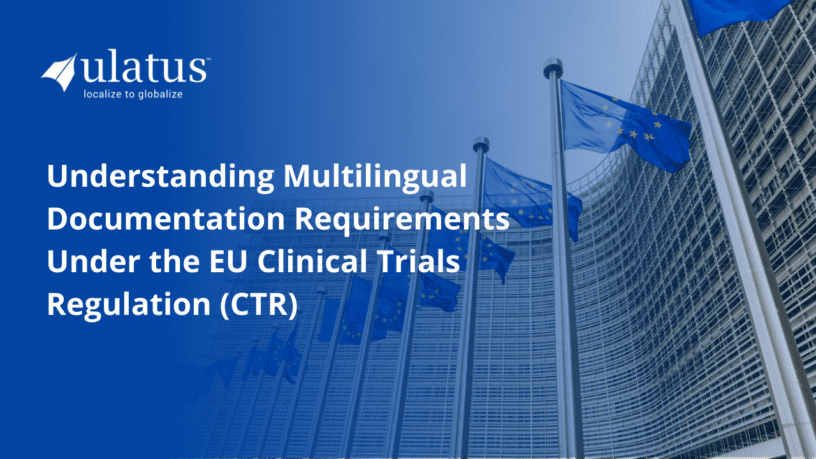The European Union Clinical Trials Regulation (CTR), which became fully effective on January 31, 2023, has redefined the requirements for clinical trial documentation across Europe. Before the CTR, each EU country had its own process for approving and managing clinical trials, often leading to inconsistencies, delays, and higher costs. The CTR aimed to address these issues by centralizing the submission, assessment, and monitoring of trials through a unified system known as the Clinical Trials Information System (CTIS). This centralization has brought greater transparency, efficiency, and harmonization to clinical trial processes, including consistent multilingual documentation.
Why Multilingual Documentation Is Important
Clinical trials often involve participants and researchers from multiple countries who speak different languages. The EU Clinical Trial Regulation translation rules ensure that everyone participants, researchers, and regulators can access and understand essential trial information. Here’s why this matters:
- Helping Participants Understand the Trial
Participants need to know exactly what they are signing up for. Translating forms and instructions into their language ensures they fully understand the risks, benefits, and procedures of the trial. - Ensuring Regulators Can Do Their Job
Regulators in each EU country must review trial documents to approve and monitor studies. These documents must be translated into the official languages of the countries where the trial is conducted. - Building Public Trust
The EU CTR emphasizes transparency, meaning trial results must be shared with the public. Providing these results in clear, easy-to-understand language builds trust in medical research.
What Documents Need Translation?
The EU CTR outlines specific documents that must be translated:
- For Participants:
Documents like Informed Consent Forms (ICFs), Patient Information Leaflets (PILs), and recruitment materials need to be in the languages participants speak. This helps them make truly informed decisions about joining a trial. - For Regulators:
Key documents such as study protocols, investigator brochures, and safety reports must be translated into the official language(s) of the countries where the trial is conducted. - For the Public:
Trial results must be shared in plain language that anyone can understand, ensuring the information is accessible to everyone, not just medical professionals.
The Challenges of Translation in Clinical Trials
Translating documents for clinical trials requires careful planning, accuracy, and specialized expertise. Here are the main challenges:
- Tight Deadlines
Regulatory authorities often need documents quickly, especially for urgent updates like safety reports. Missing these deadlines can delay or even cancel a trial. - Consistency Across Languages
Ensuring the same meaning across multiple languages is tricky. Mistakes or inconsistencies can confuse participants or lead to approval issues. - Complex Medical Language
Clinical trials involve technical and scientific terminology. Translators must accurately convey these terms while also making them understandable for non-experts. - Changing Requirements
The rules about what needs to be translated and how are regularly updated. Trial sponsors must stay informed to remain compliant.
How Language Service Providers (LSPs) Can Help
To manage these challenges, many trial sponsors hire Language Service Providers (LSPs). These companies specialize in translating medical and regulatory documents. Partnering with an LSP can help in several ways:
- Expert Translators
LSPs use professionals skilled in medical and scientific terminology, ensuring that translations are accurate and culturally appropriate. - Fast and Reliable Processes
They often use advanced tools like translation memory and artificial intelligence (AI) to accelerate the process while maintaining high quality. - Knowledge of Regulations
LSPs stay current with the EU CTR’s translation rules, helping sponsors meet all requirements without missing critical details. - Centralized Systems
Many LSPs offer project management platforms that handle translations for all documents in one place, reducing errors and ensuring consistency. - Cost-Effectiveness
Working with an experienced LSP can be more cost-effective in the long run. Mistakes or delays in translation can lead to rework, additional regulator queries, and postponed trial timelines each adding to the overall budget.
Best Practices for Handling Translations
Sponsors can take several steps to manage translations effectively:
- Start Early
Plan for translations from the beginning of the trial. Identify which documents need translating and when they’ll be required. - Work with Experts
Use professional translators who understand both technical terms and the cultural context of the target language(s). - Centralize Translations
Use a single platform to manage all translations, ensuring that documents remain consistent and easy to update. - Double-Check for Accuracy
Implement quality checks such as back-translations, where a document is translated back into the original language to ensure no details were lost or altered. - Address Cultural Nuances
Some words or phrases may not directly translate, or they might carry different connotations in another culture. Work with translators who are aware of such nuances to prevent misunderstandings. - Stay Informed
Keep up with updates to the CTR’s rules, as changes can affect what documents need translating and how they should be formatted. - Next Steps
- Develop a “translation checklist” for each phase of the trial.
- Establish a relationship with an LSP before finalizing trial documents.
- Set up a workflow in CTIS (Clinical Trials Information System) that includes translation reviews and approvals.
Making Clinical Trials Fair and Accessible
The EU CTR’s translation requirements go beyond rules and regulations; they aim to make clinical trials more accessible to everyone, regardless of their language. By providing clear, accurate translations, trial sponsors can ensure participants feel confident and well-informed. Regulators can review trials efficiently, and the public can trust the research process. In particular, plain-language summaries of trial results written in clear, non-technical language help demystify clinical findings and strengthen public engagement.
Conclusion
Translation isn’t just about meeting legal requirements; it’s about creating a system where everyone participants, researchers, regulators, and the public can engage with clinical trials fairly and safely. By investing in high-quality translations, considering cultural contexts, and partnering with professional translation services, sponsors can overcome challenges and make trials more inclusive, trustworthy, and successful. This not only helps meet the EU CTR’s goals but also strengthens the future of medical research across Europe. Sponsors who prioritize multilingual access and clarity stand to benefit from smoother regulatory processes, better participant retention, and a stronger reputation in the global research community.






Share your thoughts